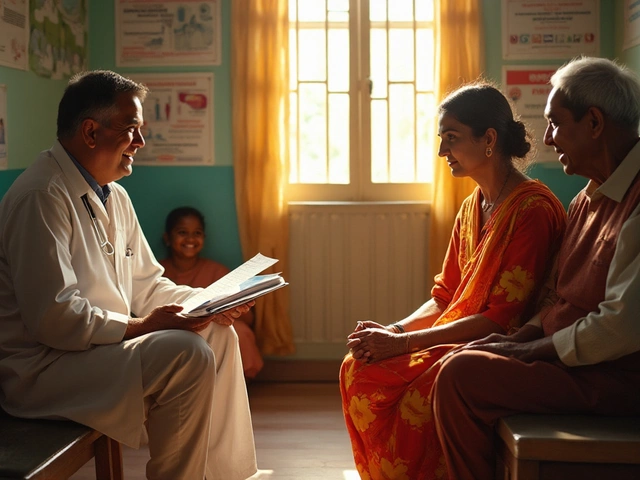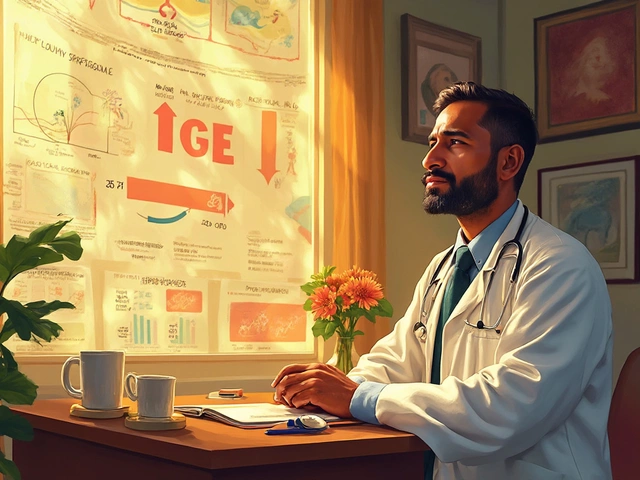Cancer's a tricky beast. When and how pain shows up largely depends on the type, location, and stage of cancer. For some folks, there's little to no discomfort in the beginning. It's like a sneaky guest that doesn't make its presence known until later. In early stages, you might just feel a vague discomfort or nothing at all.
But as cancer grows and spreads, things change. That's when pain often makes a more noticeable entrance. It's not just about where the tumor is anymore. The pressure from growth, inflammation, or even treatment side effects can crank things up a notch.
Chemo, radiation, and surgery can also play their part—sometimes causing pain to intensify or change in nature. The key is understanding what's going on and exploring ways to handle it. Accepting help and leaning on prescribed pain management strategies can make a huge difference in staying one step ahead.
- Early Stage: The Silent Pain
- Pain in the Advancing Stages
- The Role of Treatment on Pain
- Managing Cancer Pain: Tips and Tools
- The Emotional Impact of Cancer Pain
Early Stage: The Silent Pain
In the early stages of cancer, pain can be a bit sneaky. It might not scream for attention, but silently nags at the background. Whether it pricks or pinches, it's often mild and, frankly, easy to ignore or dismiss as something else entirely.
Many people at this stage may not even associate their mild symptoms with cancer. Imagine feeling an occasional dull ache or mild soreness and chalking it up to aging or an old injury flaring back. Common places where this discomfort might show up are the abdomen, where unfelt tumors in organs like the liver or pancreas reside.
Depending on where the cancer starts, pain can appear in various forms and locations. A few cancers, especially those not grown large enough to press on nerves or organs, play a stealth game for quite some time.
- Breast Cancer: Often, lumps might be felt, but any discomfort could be more due to sensitivity than actual pain.
- Prostate Cancer: Early symptoms might feel like a urinary infection, causing slight discomfort.
- Lung Cancer: A persistent, mild cough might be the only thing hinting at something deeper.
Here's where things get interesting: While pain isn't usually intense in the early phases, it's important to pay attention to these small signals. Ignoring these signs can let the cancer play its stealth game, advancing to a stage where it becomes harder to manage.
For some folks, getting annual check-ups helps in catching these early signs, even if pain isn't a factor. Picking up on such subtleties early can make a big difference, catching cancer before it grows beyond its borders.
Be aware that while the silence of early discomfort can be deceitful, acknowledging it as a possibility is crucial. Empathizing with these little nudges might just steer your path towards early intervention and effective pain management down the line.
Pain in the Advancing Stages
As cancer progresses, pain often becomes a louder part of the story. Most of the time, this happens because the tumor is growing larger and pushing against bones, nerves, or other tissues in the body. It kind of makes sense, right? More growth equals more pressure, leading to discomfort or serious pain.
For example, when a cancer spreads to the bones, it can cause severe pain. This is common in types like breast, prostate, or lung cancer. On the flip side, if cancer affects organs like the pancreas or liver, you might feel a dull ache or gnawing pain. These sensations are your body's way of telling you something's not quite right.
It's also important to know that the treatments you undergo can amplify pain. Radiation might cause burns or aches in the area being treated, and chemotherapy often causes nerve damage known as peripheral neuropathy. This isn't just about cancer pain, but the side effects of fighting the disease also play a big role.
Here's a quick look at how pain can vary:
- Localized Pain: This is where you feel pain in one spot, typically where the tumor is.
- Referred Pain: Pain felt in a different area from the tumor location, like upper back pain from liver cancer.
- Breakthrough Pain: Sudden, intense flare-ups even when you're on pain medication.
Managing pain in advanced stages is crucial. Not only does it impact your physical health, but it also affects your mental well-being. Working with doctors to try different pain relief methods can help, whether it's medications, therapies, or sometimes even alternative treatments. The idea is to combine approaches to find what suits your needs best.

The Role of Treatment on Pain
When you're dealing with cancer, treatment options like chemotherapy, radiation, and surgery are more than just part of the healing process. Each can bring about its own set of challenges, often affecting how pain is experienced.
Chemotherapy is known for its side effects. As it targets and kills rapidly dividing cells, it can lead to things like neuropathy—a type of nerve damage that causes tingling or burning sensations, especially in the hands and feet. This is a pretty common kind of cancer pain patients talk about during treatment.
Then there's radiation therapy, which is more localized and can cause skin irritation and inflammation at the site it's focused on. Over time, this can turn into a dull pain or soreness, which may last for weeks or even months after treatment ends.
Surgeries aimed at removing tumors can also be a source of temporary discomfort. After an operation, it’s normal to feel some acute pain, but this generally lessens as the body heals.
Having a good pain management plan is crucial. Doctors often recommend a combination of medications, like anti-inflammatory drugs or opioids, depending on the pain level and patient needs. Here's a quick overview of how these treatments correlate with pain management:
| Treatment | Common Pain Type | Pain Management Approach |
|---|---|---|
| Chemotherapy | Neuropathy | Painkillers, physical therapy |
| Radiation | Skin and tissue soreness | Topical treatments, pain medication |
| Surgery | Post-operative pain | Painkillers, rest, follow-up care |
The pain from cancer treatment doesn't have to be managed alone. Communicating openly with healthcare providers can lead to a tailored plan, making the journey more bearable.
Managing Cancer Pain: Tips and Tools
Dealing with cancer pain can feel like waging a constant battle, but thankfully, there are several weapons in your arsenal to fight back. The first step is acknowledging that pain doesn't have to be a solitary struggle. Communicating openly with your healthcare team is crucial because they can tailor solutions specific to your needs.
There are different types of pain management strategies, ranging from medication to alternative therapies. Generally, doctors may prescribe opioids, non-opioid medications, or even antidepressants, depending on the cause and intensity of the pain.
- Opioids are often used for severe pain and should be taken exactly as prescribed to avoid dependency issues.
- Non-opioid pain relievers like acetaminophen or NSAIDs can help with milder pains or when pain is inflammation-related.
- Antidepressants and anticonvulsants might be suggested for nerve-related pain or if your emotional state is compounding the issue.
Beyond meds, there are non-drug approaches that can make a real difference. Techniques like physical therapy, acupuncture, relaxation exercises, or massage can complement medicinal treatments and enhance overall comfort.
- Physical Therapy: Engaging in light, supervised exercises can maintain your strength and flexibility, easing pain.
- Acupuncture: Some patients find relief with this ancient technique that involves inserting thin needles into specific body points.
- Relaxation Techniques: Simple methods like deep breathing, meditation, or even guided imagery can reduce stress and alleviate pain.
- Massage: This isn’t just for relaxation; a trained professional can target muscles and soft tissues, reducing pain and improving mood.
Another underrated but powerful tool is emotional support. Whether it's through support groups, counseling, or just talking with loved ones, sharing your experiences helps lighten the load.
Creating a pain management plan together with your doctors puts you back in the driver's seat. These plans are adaptable, so don't hesitate to tweak them as necessary to keep up with your needs. Remember, with the right tools, you can make living with cancer a little more manageable.
| Strategy | Advantage |
|---|---|
| Opioids | Effective for severe pain |
| Physical Therapy | Maintains strength & flexibility |
| Relaxation Techniques | Reduces stress and pain |

The Emotional Impact of Cancer Pain
Living with cancer pain is more than just a physical challenge—it's an emotional rollercoaster that affects the well-being of the person experiencing it. The constant discomfort and awareness that something's wrong can lead to feelings of anxiety, depression, and helplessness.
One of the toughest parts of dealing with cancer is the uncertainty. Not knowing when the pain might flare up or how intense it will be can mess with your peace of mind. This anticipation can lead to a sense of dread. Plus, the energy spent battling the pain can drain your emotional reserves, leaving you feeling worn out.
Then there are the changes in the daily routine. Activities that were once enjoyable may become too strenuous or less fulfilling. This shift can lead to social withdrawal. Less interaction with friends and family can intensify feelings of isolation.
Another significant aspect is how cancer pain can affect one's identity. It's not unusual to feel like you're losing a part of yourself or mourning the life you had before the diagnosis. This emotional weight adds another layer to the challenge of living with cancer.
Support systems play a pivotal role in navigating these emotional hurdles. Connecting with others who understand, whether through support groups or therapy, can offer a much-needed outlet. Mental health professionals can provide strategies to cope and manage these feelings while ensuring that you're not just surviving, but thriving—despite the battle with both physical and emotional cancer pain. Notably, studies have shown that patients engaging in regular mental health support tend to report a 25% improvement in their overall well-being and pain management.





